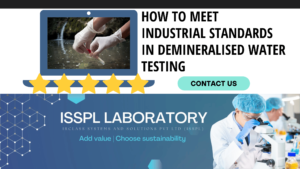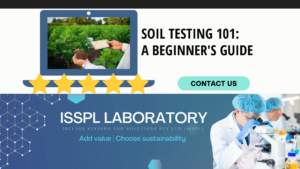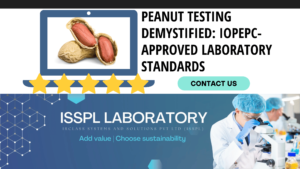An Overview by Team ISSPL - Analytical Testing Laboratory in India
ToggleDo you have an overview of the impacts of the hazardous wastes that a manufacturing unit emits? It is the need of the hour to recognize the impacts and implement an effective solution. If you cannot dispose of and handle dangerous wastes in the best possible way, it can be more than dangerous! You may get charged with a heavy penalty followed by legal hassles. It is mandatory to meet the regulatory necessities and effective guidelines. One needs to remain proactive and environmentally safe, ensuring the smooth operability of the business.
An extensive range of industrial activities, including manufacturing, construction, hospitals, farming, distilleries, and more, emits hazardous waste. The pollutant components are extremely harmful to the environment, and wildlife. It can impact human health to a large extent. This is why it is vital to conduct a program for periodic hazardous waste testing from an authorized laboratory. The lab test reports can fetch the best results, and one can make impactful decisions based on the reports.
Defining the harmful waste – The hazardous waste could be in any form or structure. It does not necessarily have to be airborne particles. It may be liquid, solid, or sludge with hazardous chemicals, heavy metals, etc. Harmful radiation and pathogen exposure are also part of the hazardous waste. It may be a by-product or manufacturing product like leftover paints, pesticides, computer equipment, batteries, etc.
Defining the waste type – According to the globally-accepted norm, the hazardous waste is produced by manufacturers and other industrial organizations. It contains various elements and properties having the ability to produce detrimental impacts. The waste is dangerous for human health and the environment. Understand that hazardous waste could get generated from more than one source. It may generate from an industrial manufacturing process. Example – Wastes or batteries and may come in diverse forms, including liquids, solids, gases, and sludges.
Hazardous waste generated by industries needs to follow the guidelines of the Hazardous waste management protocols. There are extended norms for the segregated organic residue, highly concentrated sewage like mother liquors and toxic effluents, and many more. These are not apt for physic-chemical biological treatment and thus require appropriate and unique disposal solutions.
Organizations that need a safe waste disposal solution
Which companies need to comply with the practices of proper waste disposal? All businesses, regardless of the industrial domain, must segregate their waste. It is essential to ensure the safe disposal of the waste streams. These need to get separated, packaged, and stored, as per the regulations. Recognize the hazardous components from the non-hazardous wastes and ensure the appropriate action for storing and packing them before disposing. It is vital for maintaining hygiene and health.
Besides the health aspect all businesses, companies, and manufacturers must follow disposal practices to avoid legal hazards. It may cost you heavily if the hazardous or non-hazardous waste disposal system does not comply with the laws, risk audits, or inspections compliance checks. One may need to pay a penalty, and thus, it is critical to follow apt practices. The industries and businesses that produce the maximum amount of hazardous waste are –
- Auto body shops
- Paint shops
- Printing companies that use or produce flammable ink
- Tattoo parlors
- Welding shops
- Medical care facilities and institutions, etc.
All these companies and businesses must be careful with the fines related to storing or disposing of hazardous waste. They need the apt permit with the authorized facility.
Categories of waste
- Corrosive waste – Acid is among the most common corrosive product. It is harmful and has the potential to chemically destroy tissue or metal.
- Ignitable waste – The ignitable waste can cause a fire in specific conditions. The environment protection Act includes liquids with burning points below 60 degrees Celsius in the intangible waste category. The ideal examples in this category would be compressed gas and oxidizers.
- Reactive waste – A reactive substance could explode or exhibit violent reactions under certain circumstances.
- Toxicity level – The EPA defines hazardous waste as toxic if it causes harm after getting ingested or absorbed. These are materials that could make someone sick. It may be materials that pollute the groundwater or damage the environment. Understand that all toxic waste is hazardous, but it is not ideal for all hazardous wastes.
Environmental impact – Essential to focus on
Hazardous waste can create enormous impacts on the environment. It affects the natural air, soil, water, and wildlife health. The hazardous components released by industries can degrade the natural atmosphere. The legal regulations promote the appropriate disposal and resist contamination chances.
Treatment and storage – Disposal and more
The legal bodies and regulatory authorities can create the best regulations for hazardous waste. All industries must balance their needs and work towards the mutual goal of protecting public health and the Earth’s environment. All these are possible without reducing the operational capacity. One can try multiple solutions for appropriate waste disposal, including –
- Treating or disposing of waste via incinerators or landfills
- Recycling the waste safely and effectively
- Adapt to modern techniques of disposal for effectiveness
The disposal of dangerous waste usually happens through the techniques of traditional landfills. Is it apt for all kinds of hazardous waste and industries? Maybe not. The landfill techniques cause deep penetration of toxic materials into the soil. Over time the toxic waste starts contaminating groundwater and underground water systems.
Testing and report accuracy – It matters the most.
Across the globe, the essentiality of producing accurate testing report matters significantly. For instance, the United States Environmental Protection Act or EPA is essential to measure and review the presence and concentration of physical and chemical pollutants in the disposed waste. Also, one needs to evaluate the critical properties defining the toxicity. Thus, it is indispensable to obtain accurate reports from a testing laboratory. The analyzed reports offer the best-in-class overview of the practicalities, making it apt for decision-making.
Connect to IRCLASS Systems and Solutions Pvt Ltd (ISSPL) laboratory, the one-stop partner for testing requirements. Obtain accurate reports and testing solutions with efficient processing and modern equipment pieces.







